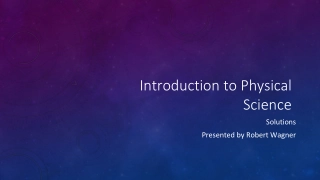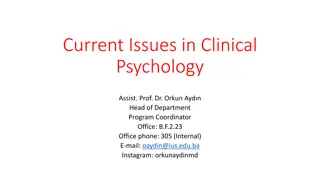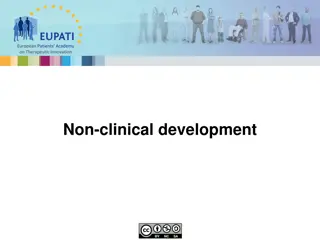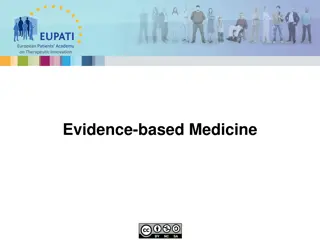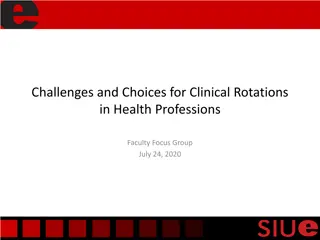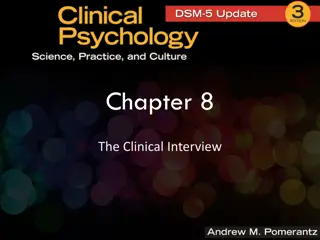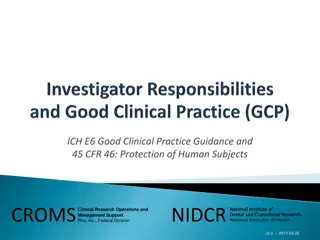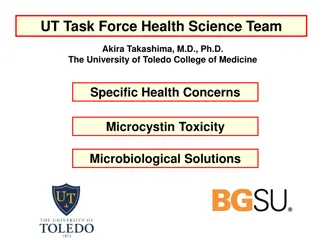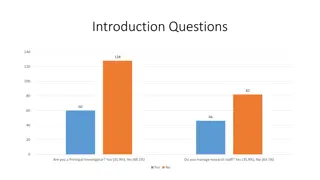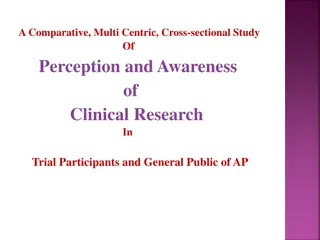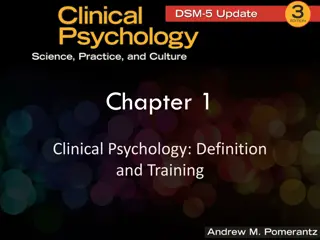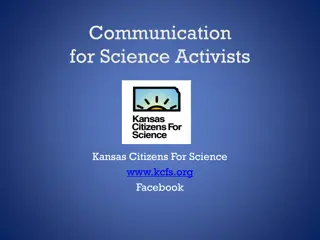Challenges and Solutions in Clinical Science Training
Challenges facing evidence-based mental health care provision in the US include incomplete knowledge, poor dissemination, and disparities in accessibility. Clinical science training aims to prepare graduates to engage in generating new scientific knowledge, providing clinical care, disseminating knowledge, and contributing to program development and evaluation.
Download Presentation

Please find below an Image/Link to download the presentation.
The content on the website is provided AS IS for your information and personal use only. It may not be sold, licensed, or shared on other websites without obtaining consent from the author. Download presentation by click this link. If you encounter any issues during the download, it is possible that the publisher has removed the file from their server.
E N D
Presentation Transcript
Strengthening Integration in Clinical Science Training Teresa A. Treat University of Iowa Note: I am a member of the PCSAS Review Committee, but the views expressed in this talk are my own and are not intended to represent the views of PCSAS or the PCSAS Review Committee.
Challenges Facing Provision of Evidence-Based Mental-Health Care in US Incomplete knowledge of psychopathology, assessment, treatment Very poor dissemination and implementation of existing treatments Marked disparities in accessibility of appropriate mental health care for broadly diverse individuals, related in part to pervasive prejudice and discrimination operating from individual to systemic levels Many front-line providers are not adequately trained to provide evidence-based psychological treatments Clinical psychologists more likely to receive evidence-based training but less likely to be full-time front-line service providers Clinical psychologists very well trained to work level or two up in clinical care contexts and have broader impact Clinical science doctoral-to-internship training designed to help address these challenges, but we have made limited progress in enhancement of public health Atkins et al., 2014; Baker et al., 2009; Berenbaum et al., 2021; Buchanan et al., 2021; Davila & Hajcak, 2012; Gal n et al., 2021; Gee et al., 2022; Kazdin & Blas , 2011; Levenson, 2014, 2017; Frank et al., 2019; McHugh & Barlow, 2010; McFall, 2006; McFall et al., 2015; Onken et al., 2014; Rodriguez-Seijas et al., 2023; Shoham et al., 2014; Treat et al., 2023; Weissman et al., 2006; Weisz et al., 2013
Clinical Science Training Ideally Designed to Prepare Grads to Do the Following: Engage in ongoing generation of new scientific knowledge Provide scientifically grounded clinical care direct service provision, clinical supervision, clinical consultation Engage in significant widespread dissemination of scientific knowledge beyond front-line service provision Formal training of service providers or other trainers Program development and evaluation Public-policy work (with program development/evaluation) Clinical administration (with training or program development/evaluation) Teaching Science-based publications/presentations, etc.
Evolution of Clinical Science Training Research training and application training in doctoral and APCS-like internship programs Individualized, flexible, innovative, multidisciplinary, science-based Integrated and bidirectionally influential (to varying degrees) PHASE ONE Application Training Research Training Application Training Research Training
Evolution of Clinical Science Training Clinical science training increasingly incorporates training in diversity (broadly construed), equity, inclusion, and social justice (DEIJ) DEIJ initially fairly silo ed, but increasingly integrated to varying degrees with research and application training PHASE TWO PHASE THREE Research Training Research Training Application Training Application Training DEIJ Training DEIJ Training
Evolution of Clinical Science Training Ideally, silos completely eliminated, three components essentially merged and bi-directionally influential Clinical science doctoral and internship programs vary in degree of integration, reciprocity of influence, etc. How would you depict your doctoral or internship program as it currently operates? PHASE FOUR How would you depict your program if it operated ideally? Why would this operation be ideal with respect to enhancement of public health? Application Training Research Training What gets in the way of your ideal program operation? What would help you to move in the direction of your ideal program? DEIJ Training
Evolution of Clinical Science Training Phase Four clinical science training across doctoral and internship programs seems well suited to producing more graduates who would develop and broadly disseminate scientifically grounded, accessible, cost-effective, and adaptable mental and behavioral health services to a highly diverse population PHASE FOUR Ongoing generation of new scientific knowledge DEIJ Significant widespread dissemination of scientific knowledge Formal training of service providers Application Training Research Training Program development and evaluation Public-policy work (with program development/evaluation) Clinical administration (with training or program development/evaluation) DEIJ Training Teaching Science-based publications, presentations Science-based clinical care Service provision, supervision, consultation
Some Barriers to Fully Integrated Clinical Science Training Silo ing and/or devaluing of research, application, or DEIJ training Some faculty only do research training, interact little with mentees about service-provision training and DEIJ, and appear to place limited value on both Some faculty only do service-provision training and DEIJ training, interact little with other faculty and students about research training and activities, and feel undervalued/underappreciated DEIJ sometimes taught only in isolated course or in isolated sections of courses/didactics, poorly integrated into research training, and often integrated into application training to limited degree
Some Barriers to Fully Integrated Clinical Science Training Limited attention to significant widespread dissemination Some faculty and students seem largely unaware of role of significant widespread dissemination in CS model Some faculty and students seem largely unaware of career paths for clinical scientists beyond mini-me s and full-time service provision Sometimes programs provide limited discussion of and training in dissemination and implementation science (D&I), although critically important to having a public-health impact Students who decide not to pursue research-focused careers may pursue full- time careers in front-line service provision in part because they know little about wealth of other career options in clinical contexts Note: Front-line service provision is also very important! My point is that CS grads are also very well-prepared to work a level or two up in clinical contexts and have a broader public-health impact. Our students don t know about these career paths unless we talk about them, place value on them, and respect the importance of high-quality and appropriately constrained clinical training within CS doctoral and internship programs.
Some Barriers to Fully Integrated Clinical Science Training Faculty in CS programs sometimes indicate that they would like to do more to address barriers mentioned above (and a wealth of other unmentioned barriers), but they Lack relevant knowledge/skills Lack necessary resources to support acquisition of knowledge/skills and their incorporation into CS training Are exhausted and burned out Soliciting resources from generous experts across clinical science doctoral and internship programs that are organized and maintained well by national organizations will be key to addressing these issues
How Strengthen Integrated Clinical Science Training? Research Training Opportunities (for Mentors) Mentors encourage integrative and innovative research training that bridges disciplines and runs the gamut from basic clinical science to D&I Mentors understand and articulate value of application training within CS model (with appropriate caps/constraints), ask mentees about service-provision training and how related to and informing research activities/ideas Mentors serve as teachers of applied material, as clinical practicum supervisors Mentors model consideration of role of DEIJ in conceptualization, assessment, and disseminable treatment of studied clinical phenomena Mentors actively support advancement of program s DEI values (e.g., contributions to diversity committee, pipeline programs, presentations that focus in part on DEIJ, mentoring of and investment in diverse students, development of and response to climate/well-being surveys, etc.) Mentors have open and respectful periodic discussions of mentees career goals and progress in program, recognize and respect that mentees interests may shift to be more clinically focused, and discuss career options in significant widespread dissemination as well as front-line service provision
How Strengthen Integrated Clinical Science Training? Application Training Opportunities (Part One) Ensure all clinical application activities provide in-model training and trainees have opportunities to work with diverse populations related to research interests Collect, examine, and act on data in all clinical care; make available for research when possible (e.g., within in-house clinics or PRNs) Infuse DEIJ into all aspects of application training (e.g., take steps to increase client diversity and service setting diversity, read/discuss/act on relevant literature, articulate role of own and clients individual differences in application activities, etc.) Consider whether advanced students might be able to do practicum training that would not be in-model with populations of primary interest or in settings/conditions of primary interest if CS faculty provide supplemental supervision
How Strengthen Integrated Clinical Science Training? Application Training Opportunities (Part Two) Provide some service-provision training in relevant research labs in doctoral programs Incorporate D&I (beyond supervision) into application training in both doctoral and internship training programs, in part so that students can articulate how D&I relevant to their clinical interests Ensure didactics in psychopathology, assessment, methods, and treatment in doctoral programs draw on service-provision material, and consider merging didactic courses on assessment and treatment with service-provision training Incorporate evaluation of application expertise into 1 or more milestones in doctoral programs Ensure key faculty doing service-provision training are appreciated, recognized, and appropriately compensated for their important work
How Strengthen Integrated Clinical Science Training? DEIJ Training Opportunities Strengthen training in role of diversity, other individual differences, and multilevel sociocultural factors in psychopathology, assessment, research methods, and treatment Infuse DEIJ into research and application training, in part so that students can articulate how and why DEIJ is relevant to their own research and clinical interests and activities Provide training in D&I that is intended in part to help prepare interested students to address widespread dissemination of evidence- based health care and marked disparities in health care APCS internships particularly well-positioned to do this, but should be done within doctoral programs as well Integrate evaluation of DEIJ expertise into 1 or more milestones in doctoral programs Mentor and invest in the training of students from disadvantaged backgrounds Assess, attend to, and respond to student issues related to program diversity, equity, climate, and well-being
Closing Comments & Suggestions Clinical scientists Engage in significant ongoing generation of new knowledge and/or significant widespread dissemination of (clinical) science Work in a wide variety of settings (medical school, neighborhood, non-profit, industry, clinical, university, government, school) Engage in a wide variety of activities (training, teaching, research, service provision, program development/evaluation, supervision, public policy, administration) Are ideally well-positioned to enhance public health How to get there from here Regularly discuss within our doctoral and internship program communities the breadth of CS model and diverse array of potential career outcomes to enhance public health and help address marked health disparities Fully merge research, application, and DEIJ training Integrate D&I into research, application and DEIJ training Thank national organization(s) for soliciting, curating, and maintaining repositories of resources provided by CS faculty in doctoral and internship programs with expertise in these areas: DEIJ training, D&I training, and fully merged CS training


